Atari at the Gazette
Antic's Infobits is their database
by Robert MacLean
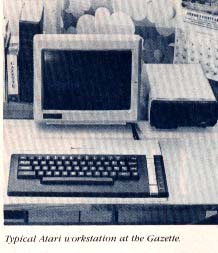
At a time when most small newspapers are switching to desktop publishing on computers with megabytes of memory, it would seem unusual for a leading local newspaper to use Atari 8-bit computers. But the Johnson's County Gazette in Olathe, Kansas uses seven Atari 8-bits to perform all computer-related tasks except billing and typesetting.
This newspaper is a tabloid feature-shopper with a circulation of 20,000 in suburban Kansas City. Our highly competitive market has four contending publications, so serious cost control is required.
In the spring of 1985, the Gazette wanted low-cost computer equipment that was efficient and useful. At that time, a whole Atari system with monitor cost $350--meaning that five work stations could be purchased for the price of one IBM PC compatible. And for the Gazette's needs in 1985, five PCs would have been overkill.
ENHANCEMENTS
Although a newspaper does mostly word processing, something more than just a 64K computer was needed to manipulate large databases and for programming. So one Atari 800XL was equipped with 256K of RAM and Omni-Mon and Omni-View hardware enhancements from CDY Consulting. We also use this computer for editing manuscripts, some of which are submitted on Atari disks and some on IBM-compatible disks. Our Happy-enhanced Atari 1050 disk drive is used to convert text files from IBM to Atari format.
Omni-View provides an 80-column display used for editing and creating tables
of information. Omni-Mon is a hardware-based means of reading and writing information
on disks so we can modify programs to suit the Gazette's needs.
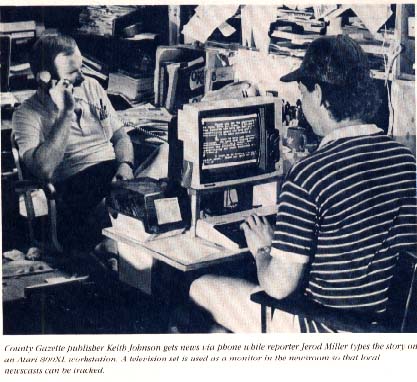
SOFTWARE USED
A modified version of the freeform database Son Of Infobits from Antic, May 1985 is used for keeping track of articles from the Gazette and other sources, plus clip-art and photo files.
Infobits uses only one field per record and it can be only three screen lines long, but searches are made on all characters in the entire file. The Gazette version automatically copies data to a RAMdisk when the computer is turned on. Searches of every word in as many as 1,500 records takes only about 30 seconds at RAMdisk speed. Results are sent to the screen or a printer. Indus GT disk drives plus an Atari 1050 with U.S. Doubler are used when we need double-density disks for large data files.
Omni-View allows an 80-column display for text produced with OmniWriter-80, the word processor supplied with the hardware. This program shares files with TextPro, an even more powerful 40-column word processor available on CompuServe. TextPro is easily adaptable for many uses by adding extensions to the program and creating macros to help with tasks such as newsletters and printed forms. TextPro is used by our area freelance writers because it is easy to learn.
The PaperClip word processor is used most often for in-house manuscript writing and correspondence. The fast print preview feature makes writing letters especially easy. Modified copies of PaperClip are used for maintaining mailing lists. Since most people are familiar with word processors, learning a database program is unnecessary. Large mailing lists can be searched quickly, edited, and printed with ease.
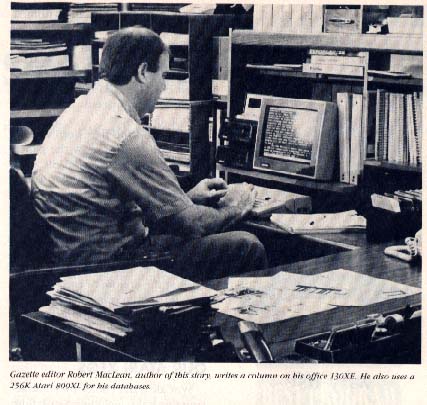
With a modification program by Dr. Warren Lieuallen, which we found on CompuServe, PaperClip can achieve a text buffer of 224,000 bytes (800 pages, double-spaced) when used with a 256K Atari.
Many programs have been written and modified for use by the paper, most of which are in Atari BASIC. One small BASIC program grew into a huge program used to keep track of distribution, which is through 50 youngsters who deliver the papers. The program calculates their pay, keeps track of papers, advertising inserts, routes, and delivery dates, and prints messages at the bottom of each carrier's pay slip. It even prints mailing labels for paychecks. The program also prints out a summary for the Gazette's accountant.
OUR ATARI XEGS
SynCalc is our choice for some accounting tasks, including a cash flow spreadsheet and some information for the circulation department. SynFile+ and the public domain DataBase II are used for lists. Antic's V-Graph (January 1987) is used to chart the Gazette's growth. We use Atari DOS 2.5 and SmartDOS because they are easy to learn.
In addition to our 80OXL and 130XE computers, the Gazette also uses an Atari XE Game System because we liked the separate keyboard. An extension cable was added immediately.
However, we were disappointed that the XEGS had no luminance output for monochrome monitors. The color output just wasn't clear enough when long hours are spent staring at a screen. Fortunately, Larry Copenhaver of The Computer Room in Kansas City made a quick modification to the unit which produces a highly readable screen output in monochrome. The parts to do this cost a whopping 40 cents! Copenhaver also developed the 256K memory upgrade used by the Gazette.
The XEGS contains the game Missile Command, of course. And while nobody at the Gazette admits playing it, a scoresheet with everyone's name and highest score is known to exist.
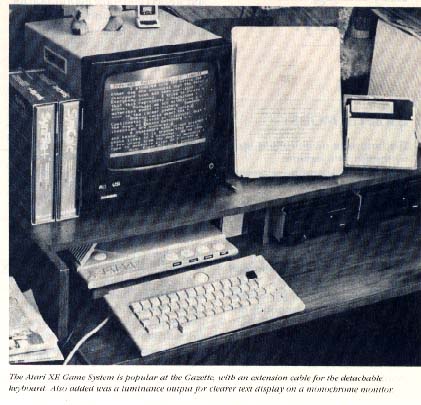
THE FUTURE
At a time when many megabytes is considered the only way to go, some people still remember that a computer is a tool used to do a job. If a small computer will do the job effectively and efficiently, why use anything more costly? The Gazette may purchase a computer suitable for desktop publishing, but we still won't give up our 8-bit Ataris. Looking forward with an eye on costs, folks at the Gazette dream of a series of desktop publishing stations, each with a laser printer.
If the Atari ST is as effective with regard to cost and performance in the future as the 8-bits have been in the past, you'll be seeing more Ataris at the Gazette office.
Johnson's County Gazette, 1004 Winterbrook, Olathe, KS 66062, (913) 782-1133
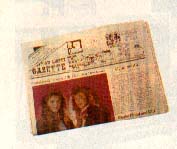
GAZETTE MODS
by Robert MacLean
The hardware modifications used by the Gazette include:
256K RAM Upgrade--increases RAM from 65,536 bytes to 262,144 bytes.
Omni-Mon--hardware enhancement that lets you examine and modify memory or the 6502 (main chip in an Atari 8-bit computer) registers as well as reading and writing to disk without DOS. It also contains program debugging tools, including a machine language disassembler.
Omni-View--hardware enhancement that produces an 80 column display on monochrome monitors with some software.
Happy 1050 disk drive--an Atari 1050 drive with a modification manufactured by Happy Computers, Inc. that lets you convert IBM and compatible disk text files for use on Atari computers or vice versa.
US Doubler--modification to a 1050 disk drive that allows true double-density disk operation.
A fan that blows filtered air into an Indus disk drive was also added. When Indus drives are used where free air movement is restricted, they may become quite warm and do some pretty strange things. The fan solved the problem for the Gazette.